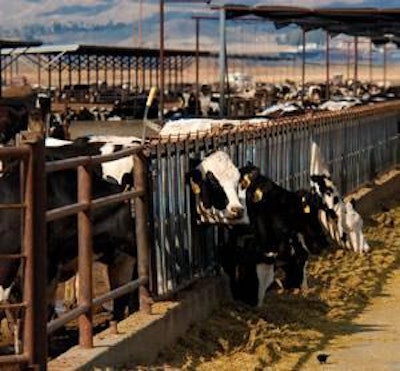
Ask most dairy nutritionists and they'll tell you distillers grains with solubles (DGS) are perfectly acceptable feed ingredient choices for dairy cattle, but they've got to be competitively priced to displace other ingredients in the diet.
"Enlisting a nutritionist who understands grouping strategies, facility limitations and feed inventories usually pays dividends as dairy operators consider adding distillers grains to their feedstuff arsenal." So says Robert M. Kaiser, University of Wisconsin-Extension dairy agent. He adds that while consistency has, and will continue to be, of concern, "savvy ethanol plant managers recognize the importance of product consistency and are beginning to provide additional services to dairy customers."
Growth of ethanol
With the push for renewable fuels in full swing, ethanol plants, both dry mill and wet mill processes, are sprouting across the Midwest, with more planned on paper and many existing facilities poised for expansions.
"Distillers grains are raising questions and concerns on North American dairy farms as corn grain prices continue to increase," points out Michael F. Hutjens, extension dairy specialist, University of Illinois.
Two methods used to produce ethanol from corn are wet milling and dry milling. Wet milling corn can yield several feed co-products, including corn gluten feed, corn gluten meal and other potential ingredients. The more popular dry mills typically produce only three: ethanol, distillers grains and carbon dioxide. "A well-managed plant utilizing modern dry mill technology generates approximately 2.7 gallons of ethanol, 18 pounds of dried distillers grains with solubles (DDGS) and 18 pounds of carbon dioxide from each bushel of corn processed," Kaiser says.
He predicts there are enough livestock operations in the U.S. to utilize the growing supply of distillers grains, but only if ethanol co-products can displace other more traditional feed grains and oil seeds, such as corn and soybean meal, at greater amounts in the dairy ration.
Ethanol production
Hutjens says corn distillers grains continue to increase in availability while prices depend on competition in the area, alternative feeds, wet versus dry corn distillers and the price of corn grain.
Marketing of wet distillers grains has developed near distilleries, adds Kaiser. The customer base has traditionally been within 150 miles of the plant because of transportation costs associated with the movement of water. From a plant operations' perspective, not having to dry all the spent distillers byproducts represents a significant energy cost savings. "Assuming this cost savings is passed on to the customer, a win-win situation is created for both entities," says Kaiser. "Ethanol plant management achieves more efficient energy production from each bushel of corn and dairy producers have the potential to realize greater income over feed costs."
Nutrient composition
As with many byproduct feeds, the nutrient composition of distillers grains is influenced by several variables including type of grain used, grain quality, grinding procedures, extent of fermentation, drying conditions, quantity of solubles blended back with the spent grain and particle separation.
Kaiser cautions that the range in values across plants, and within plants, is greater than one would typically find with whole corn. Approximately a three-fold increase in the concentration of protein, fat and fiber is found in distillers grains compared to corn, and unlike corn, which is high in starch, distillers grains are practically devoid of starch. The process also enhances the digestibility of the fiber fraction.
Highly digestible fiber and moderate fat content classify distillers grains as a high energy feed, Kaiser explains. The fermentation residues contain yeast cells, B-complex vitamins and other nutrients formed during the fermentation-distillation process. The protein quality of corn distillers grains is similar to other corn products with inherently low lysine content. Wet and dried DGS are excellent sources of ruminally undegraded protein (RUP). However, heat damaged protein may occur during the drying of distillers grains or solubles, reducing the efficiency of protein utilization by animals, something that is of greater concern with dried vs. wet distillers grains.
Elevated drying temperatures that result in acid detergent insoluble nitrogen (ADIN) levels greater than 13 percent are negatively correlated with apparent N digestibility. "Compared to corn grain, phosphorous is also concentrated three-fold in distillers grains and must be taken into consideration when formulating dairy diets to minimize phosphorous excretion into the environment," Kaiser says.
Dairy cow rations
Distillers grains of several types have been successfully built into dairy cow diets since before the turn of the century. They are not new. What is new today is the amount of biofuel co-products available and the need to manage them in a modern dairy feeding program with high-producing cows under a variety of conditions.
Thankfully, there is a great deal of research, much of which has compared the renewable energy co-products and other protein and energy feeds that have traditionally been used in dairy rations.
In fact, DDGS has become a common component of commercial dairy protein supplements, points out Kaiser, often comprising 25-35 percent of the blend on a dry matter basis, depending on price and availability. Although often looked at as an energy component of the diet, DDGS also have considerable protein. "Distillers grains are a source of rumen undegraded protein and should be positioned to replace other protein sources in the ration," adds Hutjens. "One approach is to blend 50 percent soybean meal and 50 percent distillers grains. For older heifers, dry cows, and low producing cows, DG could be the only source of supplemental protein." Kaiser says a common measurement that's often used is that one pound of DDGS is roughly equivalent to 0.6 lbs. of shelled corn plus 0.4 lbs. of soybean meal.
Kaiser points to research in Nebraska that made direct comparisons of wet versus dried distillers grains, utilizing either corn or sorghum, and the results showed little difference in production or components. Milk protein and butterfat values were similar across treatments with a slight advantage of dried vs. wet DGS. Higher moisture content of the wet DGS diets did not limit dry mater intake. There can be a difference in dry matter intake, though, if WDGS is not stored properly.
Hutjens cautions, "Quality of DG is critical. Risks that must be managed include the presence of mycotoxins in the original corn used, level of solubles added back, color of the distillers grainwhich is an indication of heat damageand storage of wet DDG."
Feeding guidelines
Both wet and dry distillers grains solubles are very palatable and can usually be utilized at up to 10 to 20 percent of the total raton dry matter for high producing cows, say both Hutjens and Kaiser.
Feeding too much distillers grain could put too much ruminally undegradable protein into the diet, which can in turn depress rumen ammonia levels and starve rumen microorganisms for nitrogen, resulting in reduced microbial protein production, decreased fiber digestion and lower dry matter intake. Hutjens says dairy managers have reported drops in milk fat test of 0.3 points or more when too much DG is included. "A lack of functional or total fiber, too much starch, high levels of unsaturated fatty acids, and/or ionophores can lead to lower fat tests," Hutjens explains.
Kaiser reminds that one of the most costly, yet common, errors is formulating a diet which limits microbial protein synthesis. Limiting the amount of crude protein coming from corn sourcesincluding corn distillers grains and any other corn-based ingredientsin a ration to 60 percent of the total crude protein is recognized as a good rule of thumb.
As corn protein is deficient in lysine, this appears to be a prudent guideline. Research has suggested the crude protein limitation may be increased if feeds high in lysine are included in multiple corn source diets.
The non-fiber carbohydrate (NFC) and starch content of dairy rations should usually not exceed 35-40 percent and 25-30 percent, respectively, or they run the risk of causing ruminal acidosis. A characteristic of distillers grains is that its net energy of lactation equals that of corn without contributing to the starch load in the rumen, says Kaiser. The low NFC as well as moderately high fat content of distillers grains may present additional nutritional concerns. Rumen microorganisms need readily available sources of energy and nitrogen to grow rapidly. This is where other ration ingredients need to compliment distillers grains. If whole oilseeds like soybean or cottonseed are fed, the maximum potential inclusion of distillers grains will likely be reduced to avoid dietary fat levels greater than 6 percent. "Additives such as yeast culture that can enhance starch fermentation in the rumen and stabilize the rumen environment would be strategically important," Hutjens says. "Increasing fiber digestion using enzymes and/or direct fed microbes would increase rumen volatile fatty acids yields while not increasing starch levels."
















